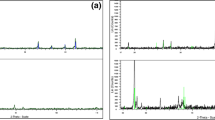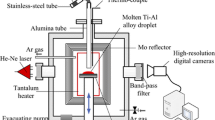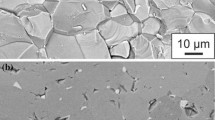Abstract
Wettability and interfacial interaction of the Ta2O5/Cu-Al system were studied. Pure Cu does not wet the Ta2O5 substrate, and improved spreading is achieved when relatively a high fraction of the active element (~40 at.% Al) was added. The Al2O3 and AlTaO4 phases were observed at the Ta2O5/Cu-Al interface. A thermodynamic evaluation allowed us to suggest that the lack of wetting bellow 40 at.% Al is due to the presence of a native oxide, which covers the drop. The conditions of the native oxide decomposition and the formation of the volatile Al2O suboxide strongly depend on the vacuum level during sessile drop experiments and the composition of the Cu-Al alloy. In our case, Al contents greater than 40% provides thermodynamic conditions for the formation of Al2O (as a result of Al reaction with Al2O3) and the drop spreading. It was suggested that the final contact angle in the Ta2O5/Cu-Al system (50°) is determined by Ta adsorption on the newly formed alumina interlayer.







Similar content being viewed by others
References
Y. Nishioka, H. Shinriki, and K. Mukai, Influence of SiO2 at the Ta2O5/Si interface on dielectric characteristics of Ta2O5 capacitors, J. Appl. Phys., 1987, 61(6), p 2335–2338
H. Shinriki, T. Kisu, S.I. Kimura, Y. Nishioka, Y. Kawamoto, and K. Mukai, Promising storage capacitor structures with thin Ta2O5 film for low-power high density DRAM’s, IEEE Trans. Electron. Dev., 1990, 37(9), p 1937–1947
E. Atanassova, T. Dimitrova, and J. Koprinarova, AES and XPS study of thin RF-sputtered Ta2O5 layers, Appl. Surf. Sci., 1995, 84(2), p 193–202
K.W. Kwon, C.S. Kang, S.O. Park, H.K. Kang, and S.T. Ahn, Thermally robust Ta2O5 capacitor for the 256 Mbit DRAM, IEEE Trans. Electron. Dev., 1996, 43(6), p 919–923
C. Chaneliere, J.L. Autran, R.A.B. Devine, and B. Balland, Tantalum pentoxide (Ta2O5) thin films for advanced dielectric applications, Mater. Sci. Eng. R, 1998, 22(6), p 269–322
Scientific Group Thermo-data Europe, Thermodynamic Data-Base SSUB3, version 3.1, Produced by Scientific Group Thermo-data Europe, 2001
P.R. Subramanian and D.E. Laughiln, The Cu-Ta (Copper-Tantalum) system, Bull. Alloy Phase Diagr., 1989, 10(6), p 652–686
Y. Du and R. Schmid-Fetzer, Thermodynamic modeling of the Al-Ta system, J. Phase Equilib., 1996, 17(4), p 311–324
W.D. Kaplan, D. Chatain, P. Wynblatt, and W.C. Carter, A review of wetting versus adsorption, complexions, and related phenomena: the rosetta stone of wetting, J. Mater. Sci., 2013, 48(17), p 5681–5717
P. Wynblatt, The effects of interfacial segregation on wetting in solid metal-on-metal and metal-on-ceramic systems, Acta Mater., 2000, 48(18–19), p 4439–4447
Z. Wang and P. Wynblatt, Wetting and energetics of solid Au and Au-Ge/SiC interfaces, Acta Mater., 1998, 46(14), p 4853–4859
N. Froumin, S. Barzilai, M. Aizenshtein, M. Lomberg, and N. Frage, Wetting induced by near-surface Ti-enrichment in the CaF2/In–Ti and CaF2/Cu–Ti systems, Mater. Sci. Eng. A, 2008, 495(1–2), p 181–186
N. Froumin, M. Piness, S. Barzilai, M. Aizenshtein, and N. Frage, Interfacial interaction between quasi-binary oxides (MgAl2O4 and Y3Al5O12) and liquid aluminum, J. Mater. Sci., 2012, 47(24), p 8450–8453
V. Laurent, D. Chatain, C. Chatillon, and N. Eustathopoulos, Wettability of monocrystalline. Alumina by aluminium between its melting point and 1273 K, Acta Master, 1988, 36(7), p 1797
N. Sobczak, R. Asthana, W. Radziwill, R. Nowak, and A. Kudyba, The role of aluminum oxidation in the wetting-bonding relationship of Al/oxide couples, Arch. Metall. Mater., 2007, 52(1), p 55–61
N. Froumin, N. Frage, M. Polak, and M.P. Dariel, Wetting phenomena in the TiC/(Cu-Al) system, Acta Mater., 2000, 48(7), p 1435–1441
I. Ansara, A.T. Dinsdale, and M.H. Rand, Cost 507: Thermochemical Database for Light Metal Alloys, Vol 2, European Communities, Belgium, 1998
M. Aizenshtein, S. Barzilai, N. Froumin, and N. Frage, Interface interaction and wetting in the Er2O3/(Cu-Al) and Er2O3/(Cu-Ti) systems, J. Mater. Sci., 2008, 43(4), p 1259–1264
S. Barzilai, M. Aizenshtein, N. Froumin, and N. Frage, Interface phenomena in the Y2O3/(Al-Cu) system, Mater. Sci. Eng. A, 2006, 420(1–2), p 291–295
S. Barzilai, H. Nagar, M. Aizenshtein, N. Froumin, and N. Frage, Interface interaction and wetting of Sc2O3 exposed to Cu-Al and Cu-Ti melts, Appl. Phys. A, 2009, 95(2), p 507–512
Author information
Authors and Affiliations
Corresponding author
Rights and permissions
About this article
Cite this article
Kish, O., Froumin, N., Aizenshtein, M. et al. Interfacial Interaction and Wetting in the Ta2O5/Cu-Al System. J. of Materi Eng and Perform 23, 1551–1554 (2014). https://doi.org/10.1007/s11665-014-0894-y
Received:
Revised:
Published:
Issue Date:
DOI: https://doi.org/10.1007/s11665-014-0894-y




